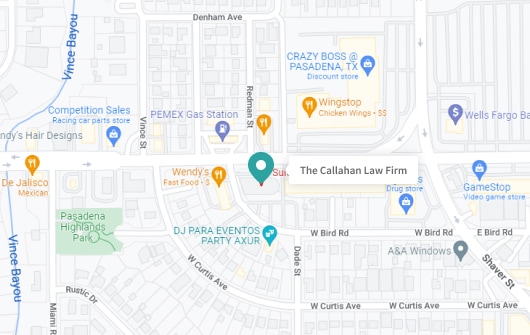Pursuing Justice: Navigating Workplace Accident Lawsuits with Confidence

In the bustling state of Texas, where industry and business thrive, an alarming statistic casts a shadow on workplace safety. In 2021, private industry employers reported a staggering 178,900 nonfatal workplace injury cases, highlighting the critical need for awareness and action in preventing such accidents.
Beyond recognizing the prevalence of workplace accidents, it is crucial to understand the steps to take immediately following an incident. Navigating the aftermath of a workplace accident can be confusing as you try to find appropriate medical care, determine reporting procedures, and consider legal action.
Knowing what to do in these situations is essential for protecting your rights and ensuring you receive the necessary support and compensation. For help after a workplace accident, contact The Callahan Law Firm to schedule a no-cost consultation. With more than 25 years of experience, we’ll help you with your next steps.
What is a Workplace Accident Lawsuit?
A workplace accident lawsuit is a legal claim an employee makes against their employer, or someone else at the workplace who was responsible, following an injury or illness that arises in the course of employment duties. The aim of the lawsuit is to seek compensation for losses sustained as a result, such as lost wages, medical bills, and pain and suffering in some instances. Understanding common causes of these accidents can help you determine if you have a cause of action.
What are Some Common Causes of Workplace Accidents?
Understanding common causes of workplace accidents is crucial, as this knowledge paves the way for prevention. Some of the most common causes include the following:
- Inadequate Training: When employees are not properly trained to safely perform their job duties, the risk of accidents increases significantly. Lack of training can lead to improper machinery handling, failure to recognize hazardous situations, or inability to respond effectively to emergencies, ultimately resulting in workplace injuries.
- Inadequate Maintenance: Regular maintenance of equipment and workspaces is crucial for ensuring safety. When maintenance is neglected, machinery can malfunction, structures can become unsafe, and tools can fail, all of which can lead to accidents. Inadequate maintenance often results in preventable hazards that pose serious risks to employee safety.
- Insufficient Personal Protective Equipment (PPE): PPE is essential for minimizing exposure to workplace hazards. When employers fail to provide sufficient PPE, or when employees do not use it correctly, they are more susceptible to injuries from exposure to harmful substances, physical hazards, or other dangerous conditions.
- Fatigue: Overworking or insufficient rest can lead to fatigue among employees, which impairs judgment, slows reaction times, and reduces attention to detail. Fatigue is a common factor in workplace accidents, as tired workers are more prone to making mistakes or overlooking safety protocols.
Regardless of the nature of your occupational accident, it’s essential to grasp the common causes. This will inform you about potential safety measures and better prepare you to take action once an accident occurs.
Steps to Take if You’ve Been Injured in a Workplace Accident
If you’ve been injured in a workplace accident, it’s crucial to take immediate and appropriate steps to protect your safety, health, and legal rights. Here are the essential steps to follow if you find yourself in this unfortunate situation:
Seek Medical Attention
First and foremost, your health and well-being should always be the top priority. Despite how minor an injury might seem initially, symptoms sometimes have a delayed onset. Always see a doctor or go to the hospital as soon as possible after an injury occurs. Your health is invaluable, and it’s important to prioritize it above all else.
Report the Accident
It’s also critical that you promptly report the incident to your employer or supervisor, in line with company policy, if one exists. You might be required to complete an accident report or additional paperwork, and you should always ensure that you maintain copies of all completed documents.
Document Everything
In the context of workplace accident claims, the more evidence you can gather to support your version of events, the stronger your case will likely be. While the incident is fresh in your memory, jot down detailed notes about the events leading up to and following your injury. This should include the date, time, workplace conditions, a description of how the accident occurred, and any other pertinent details.
Identify Witnesses
Witness testimony often plays an important role in substantiating your claim. Identify potential witnesses to your accident and gather their contact information so your lawyer can speak with them.
Log All Expenses and Lost Wages
Keep track of all medical bills, medication receipts, and records pertaining to other expenses linked to your injury in an organized manner. This includes recording any work missed due to the injury or subsequent therapy sessions for emotional injuries.
Attend All Follow-Up Appointments
Attending all scheduled follow-up appointments is critical to demonstrating a commitment to your recovery. Make a note of these visits, as they constitute evidence of the impact and duration of your injury and related hardships.
Seek Legal Advice
Consulting with a lawyer experienced in workplace injury lawsuits will give you insight into your rights and how to proceed. They will assist you with filing a lawsuit if appropriate so you can obtain the compensation and justice you’re entitled to.
Understanding these key steps empowers you to respond efficiently. It paves the way for any legal claims that follow, which are most likely to include a workers’ compensation claim or a workplace accident lawsuit.
Compensation That Can Be Obtained After a Workplace Injury
In Texas, the type of compensation you can obtain after a workplace injury depends on whether you pursue a workers’ compensation claim or a personal injury lawsuit. Each path offers slightly different types of compensation:
Workers’ Compensation Claim
In a workers’ compensation claim in Texas, the following benefits may be available:
- Medical Expenses: Covers necessary medical treatment related to the workplace injury, including hospital visits, medications, physical therapy, and any ongoing medical care.
- Income Benefits: Provides a portion of your lost wages if the injury results in time away from work. This includes Temporary Income Benefits (TIBs), Impairment Income Benefits (IIBs), Supplemental Income Benefits (SIBs), and Lifetime Income Benefits (LIBs), depending on the nature and duration of your disability.
- Death Benefits: If a workplace injury results in death, the worker’s dependents may receive death benefits, including a portion of the deceased worker’s wages and coverage for funeral expenses.
- Vocational Rehabilitation Services: In some cases, if you are unable to return to your previous job, workers’ comp may provide training for a new position.
Workers’ compensation in Texas is a no-fault system, meaning you can receive benefits regardless of who was at fault for the injury. However, accepting workers’ compensation generally waives your right to sue your employer for additional damages.
Personal Injury Lawsuit
If you’re able to file a personal injury lawsuit instead, you are likely entitled to the following:
- Medical Expenses: Similar to workers’ comp, you can recover the cost of medical treatment.
- Lost Wages and Lost Earning Capacity: You can claim compensation in full for the time you were unable to work and any future earnings lost due to the injury.
- Pain and Suffering: Pain and suffering damages are compensation for physical pain and emotional distress caused by the injury can be recovered.
- Punitive Damages: In cases of gross negligence or malicious intent, punitive damages may be awarded to punish the wrongdoer and deter similar conduct in the future.
A personal injury lawsuit is typically pursued when the injury is not caused by your employer who carries worker’s compensation or caused by a third party’s actions, and it requires proving that the party was at fault.
When Can an Injured Worker File a Workers’ Comp Claim?
In Texas, an individual can file a workers’ compensation claim if they meet certain criteria. First, their employer must have workers’ compensation insurance, which isn’t guaranteed, as it is not mandatory for most employers in the state to carry this coverage.
The claimant must be an employee of the company, as independent contractors and some other worker categories may not be eligible. Additionally, the injury or illness for which the claim is being made must be work-related and occur during the course of employment.
While workers’ compensation claims provide essential benefits for workplace injuries, there are limitations and certain scenarios where an injury might be excluded from coverage. For instance, injuries that occur due to an employee’s intoxication or drug use, self-inflicted harm, or involvement in illegal activities are generally not covered.
When is a Personal Injury Claim Filed Instead of a Workers’ Comp Claim?
Navigating the aftermath of a workplace injury can be a complex process, especially when it becomes evident that a workers’ compensation claim isn’t possible. Here’s when a personal injury claim may be filed instead:
- Employer Does Not Have Workers’ Compensation Insurance: Most employers in Texas are not required to carry workers’ compensation insurance. If your employer does not have this coverage, you cannot file a workers’ comp claim and may pursue a personal injury lawsuit instead.
- Injury Caused by a Third Party: If your workplace injury was caused by someone other than your employer – for example, a contractor or another driver in a vehicle accident – you may file a personal injury claim against that third party.
- Employer’s Gross Negligence or Intentional Harm: If your injury resulted from your employer’s gross negligence or intentional actions, you might be eligible to file a personal injury lawsuit. In such cases, workers’ compensation may not provide an adequate remedy, and a lawsuit can seek broader damages, including punitive damages.
- Injury Due to Defective Products or Toxic Substances: If your injury was caused by a defective product (like malfunctioning machinery) or exposure to toxic substances, you might be able to pursue a personal injury lawsuit against the product manufacturer or supplier.
Understanding the distinction between workers’ compensation and personal injury claims is crucial if you’ve been injured in the workplace, as it empowers you to choose the most appropriate legal avenue for seeking justice and securing the compensation you rightfully deserve.
Contact The Callahan Law Firm For Help With a Workplace Injury
Workplace accident lawsuits play a crucial role in holding negligent parties accountable and securing the compensation injured workers rightfully deserve. While each case presents its own unique challenges, having a general understanding of the process can empower you during this tough time.
If you’ve been injured on the job due to someone else’s negligence, now is the best time for you to take action. Contact The Callahan Law Firm today; our legal team is committed to fighting fiercely on your behalf until justice is served.
Frequently Asked Questions
Q: How long do I have to sue for work-related injuries in Texas?
In Texas, you usually have two years from the date of your work-related injury to file a lawsuit if you’re eligible to file a lawsuit. This timeframe is known as the statute of limitations. However, there could be exceptions depending on the circumstances, so consulting with an attorney right away is the best way to safeguard your rights.
Q: What happens if you are injured on the job or at work?
If you’re injured at work, your next steps will largely depend on the specifics of your situation. If your employer has workers’ compensation insurance, you can initiate a workers’ comp claim seeking benefits provided by such policies.
For those injured at workplaces without this coverage, you may be able to pursue legal action through a personal injury lawsuit, depending on the circumstances.
Q: Who is liable for workplace accidents?
Determining liability in workplace accidents requires careful investigation and understanding of the circumstances. Possible entities that could be liable include the employer, a co-worker, an independent contractor, a manufacturer of machinery, or even the injured party themselves.

Michael S Callahan is an attorney and founder of The Callahan Law Firm. He focuses his practice on representing individuals and families in personal injury cases involving motor vehicle and truck accidents, workplace accidents and defective products. With over 25 years of experience, he is dedicated to fighting on behalf of people whose lives have been forever altered by the negligence and carelessness of corporations and individuals. Originally trained as a mechanical engineer, Michael has been practicing law and fighting for justice for those who need it most since 1994. He is board-certified in Personal Injury Trial Law by the Texas Board of Legal Specialization and a member of various esteemed legal associations. Outside of work, Michael enjoys spending quality time with his family, outdoor activities, and continually striving to improve as a trial lawyer and human being.











